Related Research Articles

Sir Donald George Bradman, AC, nicknamed "The Don", was an Australian international cricketer, widely acknowledged as the greatest batsman of all time. Bradman's career Test batting average of 99.94 has been cited as the greatest achievement by any sportsman in any major sport.

Bill Voce was an English cricketer who played for Nottinghamshire and England. As a fast bowler, he was an instrumental part of England's infamous Bodyline strategy in their tour of Australia in 1932–1933 under Douglas Jardine. He was born at Annesley Woodhouse, near Kirkby-in-Ashfield, Nottinghamshire. He died at Lenton, Nottingham.

Sidney George Barnes was an Australian cricketer and cricket writer, who played 13 Test matches between 1938 and 1948. Able to open the innings or bat down the order, Barnes was regarded as one of Australia's finest batsmen in the period immediately following the Second World War. He helped create an enduring record when scoring 234 in the second Test against England at Sydney in December 1946; exactly the same score as his captain, Don Bradman, in the process setting a world-record 405-run fifth wicket partnership. Barnes averaged 63.05 over 19 innings in a career that, like those of most of his contemporaries, was interrupted by the Second World War.

John Henry Webb Fingleton was an Australian cricketer, journalist and commentator. The son of Australian politician James Fingleton, he was known for his dour defensive approach as a batsman, scoring five Test match centuries, representing Australia in 18 Tests between 1932 and 1938.

Ian William Geddes Johnson, was an Australian cricketer who played 45 Test matches as a slow off-break bowler between 1946 and 1956. Johnson captured 109 Test wickets at an average of 29.19 runs per wicket and as a lower order batsman made 1,000 runs at an average of 22.92 runs per dismissal. He captained the Australian team in 17 Tests, winning seven and losing five, with a further five drawn. Despite this record, he is better known as the captain who lost consecutive Ashes series against England. Urbane, well-spoken and popular with his opponents and the public, he was seen by his teammates as a disciplinarian and his natural optimism was often seen as naive.
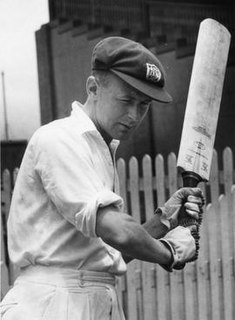
Arthur Robert Morris was an Australian cricketer who played 46 Test matches between 1946 and 1955. An opener, Morris is regarded as one of Australia's greatest left-handed batsmen. He is best known for his key role in Don Bradman's Invincibles side, which made an undefeated tour of England in 1948. He was the leading scorer in the Tests on the tour, with three centuries. His efforts in the Fourth Test at Headingley helped Australia to reach a world record victory target of 404 on the final day. Morris was named in the Australian Cricket Board's Team of the Century in 2000 and was inducted into the Australian Cricket Hall of Fame in 2001.

Colin Leslie McCool was an Australian cricketer who played in 14 Tests from 1946 to 1950. McCool, born in Paddington, New South Wales, was an all-rounder who bowled leg spin and googlies with a round arm action and as a lower order batsman was regarded as effective square of the wicket and against spin bowling. He made his Test début against New Zealand in 1946, taking a wicket with his second delivery. He was part of Donald Bradman's Invincibles team that toured England in 1948 but injury saw him miss selection in any of the Test matches.
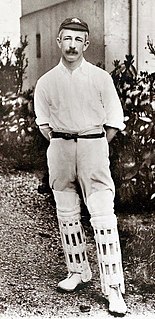
Hanson "Sammy" Carter was a cricketer who played for Australia and New South Wales.
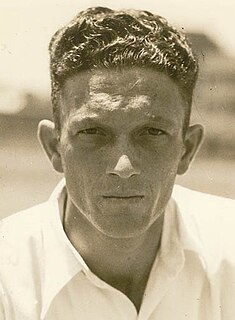
Donald Tallon was an Australian cricketer who played 21 Test matches as a wicket-keeper between 1946 and 1953. He was widely regarded by his contemporaries as Australia's finest ever wicket-keeper and one of the best in Test history, with an understated style, an ability to anticipate the flight, length and spin of the ball and an efficient stumping technique. Tallon toured England as part of Don Bradman's Invincibles of 1948 and was recognised as one of the Wisden Cricketers of the Year in 1949 for his performances during that season. During his Test career, Tallon made 58 dismissals comprising 50 catches and 8 stumpings.
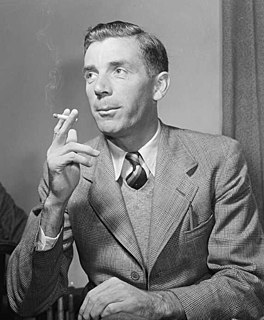
Douglas Vivian Parson Wright, better known as Doug Wright, was an English cricketer. A leg-spinner for Kent and England from 1932 to 1957 he took a record seven hat-tricks in first-class cricket. He played for Kent for 19 seasons and was their first professional captain from late 1953 to 1956. Don Bradman said he was the best leg-spinner to tour Australia since Sydney Barnes, and Keith Miller thought he was the best leg-spinner he had seen apart from Bill O'Reilly. He toured Australia in 1946–47 and 1950–51, but was dogged by ill-luck and was considered to be the "unluckiest bowler in the world".
Cutting a leg-break is always dangerous, and cutting Wright is a form of suicide. Why a bowler of his skill failed to get more test-match wickets always mystified me; there was of course the marked tendency to bowl no-balls, but he sent down so many good ones, and worried and beat the batsmen so often, that he should have had better results...he seemed always likely to get wickets. It is one of the toughest problems of captaincy to know when to remove a man like that from the firing-line.
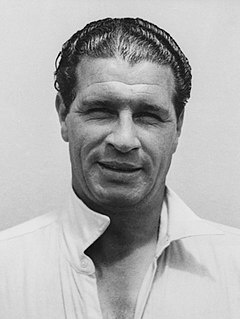
Ernest Raymond Herbert Toshack was an Australian cricketer who played in 12 Tests from 1946 to 1948. A left arm medium paced bowler known for his accuracy and stamina in the application of leg theory, Toshack was a member of Don Bradman's "Invincibles" that toured England in 1948 without being defeated. Toshack reinforced the Australian new ball attack of Ray Lindwall and Keith Miller.
Richard Pollard was an English cricketer born in Westhoughton, Lancashire, who played in four Test matches between 1946 and 1948. A fast-medium right-arm bowler and a lower-order right-handed batsman who made useful runs on occasion, he played for Lancashire between 1933 and 1950, taking 1,122 wickets in 298 first-class matches; he is 10th highest wicket-taker for Lancashire.
The English cricket team in Australia in 1946–47 was captained by Wally Hammond, with Norman Yardley as his vice-captain and Bill Edrich as the senior professional. It played as England in the 1946–47 Ashes series against the Australians and as the MCC in their other matches on the tour. They were regarded as a sound team which was just as strong as Australia, but due to the Second World War they were an ageing side and their bowling depended heavily on Alec Bedser and Doug Wright, who were overused and exhausted as a result. Australia beat England 3-0 in a five-match series to retain the Ashes; England suffered the worst defeat in a Test series since losing 4–1 to Australia in 1924–25. Since 1881, Tests in Australia were played to finish. That rule was changed for this series, and for the first time in 65 years, a test played in Australia ended in a draw when the third test was drawn.
During his career, there were many controversies involving Australian cricketer Don Bradman.

During the 1946–47 Australian cricket season, all rounder Keith Miller represented Victoria and Australia. A 27-year-old right-handed batsman and fast bowler, Miller played in all five Tests against England, performing well with both bat and ball. He finished top of the Australian Test bowling averages, taking 16 wickets at 20.88, and was second in the batting averages, scoring 384 runs at 76.80. On his Ashes debut in the First Test in Brisbane, Miller scored 79 before taking match bowling figures of 9 wickets for 77 runs (9/77) in Australia's innings victory. In the Fourth Test, played at the Adelaide Oval, Miller broke through for his first Test century, scoring an unbeaten 141. A middle-order batsman and right-arm opening bowler, Miller finished the Test series as Australia's joint leading wicket-taker, along with his new ball partner Ray Lindwall, as Australia won the series 3–0.

The 1946–47 Ashes series consisted of five cricket Test matches, each of six days with five hours play each day and eight ball overs. Unlike pre-war Tests in Australia, matches were not timeless and played to a finish. It formed part of the MCC tour of Australia in 1946–47 and England played its matches outside the Tests in the name of the Marylebone Cricket Club. The England team was led by the veteran Wally Hammond and his vice-captain Norman Yardley with the strong batting line up of Len Hutton, Cyril Washbrook, Bill Edrich, Denis Compton and Joe Hardstaff, but a weak bowling attack that relied on pre-war bowlers like the 37-year-old Bill Voce of Bodyline fame and the mercurial leg-spinner Doug Wright. The two successes of the tour were the newly capped Alec Bedser, who would carry the England bowling attack until 1955, and Godfrey Evans who would be England's first choice wicketkeeper until 1959. England had drawn the Victory Tests 2–2 in 1945 and were thought to be equal in strength, but Hammond lost 3–0 to Don Bradman's Australian team which had only two other pre-war players – Lindsay Hassett and Sid Barnes, who had played 5 Tests between them – and was packed with fresh talent in the shape of Arthur Morris, Keith Miller, Ray Lindwall, Colin McCool, Ernie Toshack and Don Tallon. There were several controversial umpiring decisions which assumed greater significance as they favoured Australia and in particular Don Bradman.
The 1946–47 Australians defeated the touring England team 3–0 in the 1946–47 Ashes series. First-class cricket had continued in Australia until January 1942 and as grade cricket had continued throughout the war there had been less of an hiatus than in England. Their cricket grounds had not been bombed and compared to austerity Britain, Australia was a land of plenty, which allowed for a more rapid recovery than in the old country, as had happened after the First World War. There was no Sheffield Shield in 1945–46, but the Australian Services XI had played all the states and there had been non-Shield interstate games. However, Australia's main advantage was the encouragement of their younger players, in particular by Bradman. Though overshadowed by the great 1948 Australian team, in 1975 Don Bradman reckoned that it was Australia's strongest post-war home team, with the 1974–75 Australians coming a close second and the 1950–51 Australians third. It was also superior to the pre-war Australian teams, as though they were just as strong in batting they had no fast bowlers and depended heavily on the leg-spin of Clarrie Grimmett and Bill O'Reilly. In 1946–47 Ray Lindwall and Keith Miller emerged as a great new-ball partnership, with quality support from Ernie Toshack, Ian Johnson and Colin McCool. The only area for improvement was in finding another top-order strokemaker, which was soon resolved by the arrival of Neil Harvey.

The Marylebone Cricket Club tour of Australia in 1946-47 under the captaincy of Wally Hammond was its ninth since it took official control of overseas tours in 1903-1904 and the first since the Second World War. The touring team played as England in the 1946–47 Ashes series against Australia, but as the MCC in all other games. In all there were 25 matches; 5 Test matches, 13 other First Class matches and 7 minor matches. Australia had been suffering a drought since 1937, but this ended as it rained in every match the MCC played on tour, including tropical thunderstorms twice in Brisbane and again in Sydney. However, this had an adverse effect on the pitches and denied the touring team adequate practice and lead to many draws.
Hammond's ill-equipped army returned to England beaten, yet deserving of the highest honours for their sportsmanship, their ability to smile in the face of certain disaster and also for their success in gaining the objective of their invasion - the spreading of cricket goodwill from the Homeland to a Dominion.
The England team were unhappy with the umpiring in the 1946–47 Ashes series, in particular when Don Bradman was not given out when caught by Jack Ikin for 28 in the First Test and 22 in the Second. Test cricket was not filmed except for highlights and the notion of Test umpires using slow-motion replays or other modern techniques would have been considered absurd. Instead the umpires had to make judgements based on what they saw in a split-second, and honest mistakes were accepted as part and parcel of the game. However, touring teams sometimes felt that there was a natural bias towards the home team which led to some acrimony if important decisions always went against them. The Australian Ray Robinson wrote in The Cricketer:
Usually debatable decisions work out fairly evenly over a Test rubber, but weight of evidence suggests that the umpires were mistaken in giving Bradman not out caught for 28 in the First Test, Edrich out leg-before-wicket for 89 in the Third Test, and Washbrook out caught behind the wicket for 39 in the Fourth Test. These decisions came at such points in England's bids to gain an advantage that they could almost be termed turning-points of the three games.
References
- ↑ Alan Kippax, forward to Clif Cary, Cricket Controversy, Test matches in Australia 1946-47, T. Werner Laurie Ltd, 1948
- ↑ p32, Cary
- ↑ p84, Brett Hutchins, Don Bradman: Challenging the Myth, Cambridge University Press, 2005
| This biographical article related to Australian cricket is a stub. You can help Wikipedia by expanding it. |